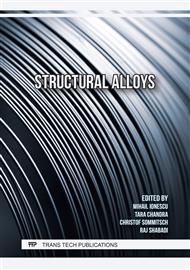p.59
p.65
p.73
p.79
p.85
p.91
p.97
p.103
p.109
Factor for Improvement of Plastic Workability in Magnesium Alloy Pipes through Processing by Torsion and Back-Torsion
Abstract:
Magnesium alloys have the advantages being lightweight and high recyclability. On the other hands, it is thought that magnesium has the disadvantage of poor plastic workability at room temperature due to its crystal structure. Especially, in pipe materials, winkles occur on the compressed side during bending. We aim to improve the bending workability in magnesium alloy pipe by torsion and back-torsion. In this study, tensile and compressive tests using specimens of pipes processed by torsion and back-torsion showed reduction the difference of yield stress. Microstructural observation of processed pipes revealed reducing crystal grain size and forming deformation twinning. Vickers hardness tests shows increasing hardness by torsion and back-torsion. Moreover, bending tests showed decreasing flatting ratio by torsion and back-torsion. These results demonstrated that torsion and back-torsion have effect of improvement in bending workability for magnesium alloy pipes.
Info:
Periodical:
Pages:
85-90
Citation:
Online since:
December 2023
Authors:
Price:
Сopyright:
© 2023 Trans Tech Publications Ltd. All Rights Reserved
Share:
Citation:



